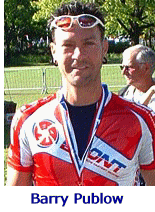 |  | |||||||||||||||||||||||||||||||||||||||
 | ||||||||||||||||||||||||||||||||||||||||
Inline Marathoning > Advanced Skills Marathon Training and Racing for the Advanced Competitor
That's not to say that it's not good for you. Piling on the miles will burn calories, improve your cardiovascular performance, and elevate your relative muscular endurance. But these are NOT the things that allow you to go fast over a distance of 26 miles! The only way to race fast is to train fast, and this is where interval and "fartlek" training come into play. Most skaters know what interval training is. But few understand the science behind it. As a result, they don't know how to adapt it to the events they are preparing for. They do the same intervals whether they are preparing for a 10K or a marathon. And that's simply wrong. Here are some rules to keep in mind: No. 1 No. 2 No. 3 No. 4 No. 5 No. 6 Go to: Part 1: Marathon Training for Advanced Skaters Part 2: Want to race fast? ... train fast! Part 3: Interval training for marathon skaters Part 4: Maximizing Your Starts and Resting While You Race Related reading: • Beginner's guide to outdoor racing. (Copyright 2006 Barry Publow) (Barry Publow is coach of the Canadian national inline speed skating team and a former national champion. He is the author of Speed on Skates and an expert on sport-specific technique, biomechanics and training application. At his Breakaway SpeedCamps, he has shared his knowledge of skating with hundreds of skaters in Canada, the United States and Europe.) Related reading: | Go to: Part 1: Marathon Training for Advanced Skaters Part 2: Want to race fast? ... train fast! Part 3: Interval training for marathon skaters Part 4: Maximizing Your Starts and Resting While You Race Related reading: | |||||||||||||||||||||||||||||||||||||||
... Copyright © 2006 by Robert Burnson | ||||||||||||||||||||||||||||||||||||||||

